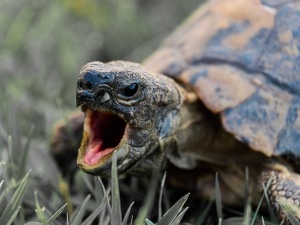
Tortoises are the most fragile and sensitive when they are young, and they are more susceptible to developing a number of ailments and issues at this time
This article looks into the leg problems that your baby tortoise may develop.
Table of Contents
Baby tortoise leg problems
If you’re looking for a pet that is relatively easy to raise then a tortoise will be a good choice for you, however, these animals still need some level of care and attention.
If your pet doesn’t get care and attention then problems may start to develop specifically in their legs. Here are the common baby tortoise leg issues that you should look out for:
Malnutrition:
One of the main things that can cause issues in your tortoise’s legs is malnutrition.
A calcium deficiency, calcium or phosphorous imbalance, or a vitamin D deficiency can cause issues in your pet’s bones and nerves in the legs.
If there are issues with your pet’s bones or nerves then your pet may start to develop mobility issues that affect the legs.
If your pet has issues with its diet then it can also develop constipation, or GI impaction as these digestive issues may put pressure on your pet’s hind legs.
What to do:
Making sure that your pet’s diet is tailored for its species and age will keep malnutrition at bay.
If your pet starts developing these issues then taking your pet to a vet is recommended.
Injuries:
Not only are adult tortoises prone to attacks from your domestic pets and other animals, your baby tortoise is at even more risk because it is so small and easy to swallow
If a predator does not eat a tortoise it may still injure the little reptile’s leg and cause serious damage.
Animals as small as rats can also gnaw at your baby’s tortoise legs and cause severe damage
What to do:
Any tortoise attack from an animal will warrant a vet’s visit.
Wild animals can cause serious injuries to your little tortoise and if not treated your pet reptile can die
Keep your baby tortoise safe by making sure that other animals don’t have access to your tortoise’s enclosure
If you choose to let your tortoise out then cover the enclosure to keep any animals out. Make sure that the enclosure is covered with a sturdy material.
Abscess:
Another leg issue that you should look out for in your baby tortoise is an abscess.
If your baby tortoise suffers a small injury to its leg, and the area becomes infected with bacteria, then an abscess may form.
Injuries may develop in your pet while it is wandering around the garden.
Abscesses will look like big bumps in your tortoise’s skin, the material on the inside of the abscess has a cheesy-like consistency.
The consistency of the material in the abscesses of tortoises is thicker than the material in a human’s abscess.
What to do:
If you think that your little tortoise has an abscess then it is recommended that you take your pet to the vet to be diagnosed and treated.
The best way to remedy an abscess is for it to be opened up and drained.
After draining, your vet will clean the opening thoroughly to get rid of any harmful bacteria.
Antibiotics will be given to your pet after cleaning.
The choice of the antibiotic given will be determined by which bacteria infected your pet.
If this condition is not treated then there is always a chance that the bacteria may enter the little reptiles’ bloodstream and cause a generalized infection.
Abscesses can be fatal so watch out for them and take your infected pet to the vet when you see them developing.
If you enjoyed this article then you may also be interested in other turtle/tortoise related articles. Here are some articles that you may be interested in: Tortoise Bleeding Leg, Tortoise Cut On Leg, Tortoise Having Trouble Walking At Night, Turtle Bulging Out Of Shell, Red Spots On Turtle Belly, Algae Growing On Turtle Head, Adding Salt To A Turtle Tank, Wheat Germ Pellets For Turtles, How To Fix Retained Scutes

